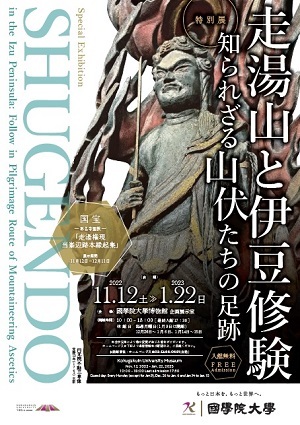SHUGENDO in the Izu Peninsula: Follow in the Pilgrimage Route of Mountaineeing Asceticsies
Term:Nov. 12st, 2022 - Jan. 22th, 2023
We have English explanation part in this exhibition.
In the middle ages, there were numerous Shugendō practitioners in Izu Coutry. Their base shrine, Sōtō-san, was a major sacred site in eastern Japan. It was known as Sōtō Gongen or Izu Gongen until it was renamed Izusan Shrine due to government policies separating Shinto and Buddhism in the early Meiji period (1868). Here, we will discuss the origins of Shugendō, a religion unique to Japan, and its founder, En-no-Gyōja Jinben Daibosatsu, and then introduce the history and religion of Izu Sōtō-san and Izu Shugendō, the reality of which has not been described until now. Incidentally, 2022 marks 150 years since the edict banned Shugendō (1872). In forming a modern state, the government also sought, sometimes successfully and sometimes not, to rationalize religion by making Shinto a national religion, separating Shinto and Buddhism, abolishing hereditary Shinto priesthood, banning Onmyōdō and Shugendō, and consolidating various Buddhist sects and schools. This exhibition is part of an attempt to recreate the tradition of Izu Shugendō practitioners, which has been lost amidst such twists and turns, through historical and archaeological methods.
*Flyer
Outline
| Term | Nov. 12st, 2022 - Jan. 22th, 2023 |
|---|---|
| Place | Kokugakuin University Museum, Special Exhibition Space |
| Admission Fee | Free |
| Access | Accessible on foot or by bus, 10-15 minutes from Shibuya, Omote-sandō, or Ebisu Station. Directions to Kokugakuin University Museum |
| Hours | From 10:00 to 18:00(Last admission 17:30) |










